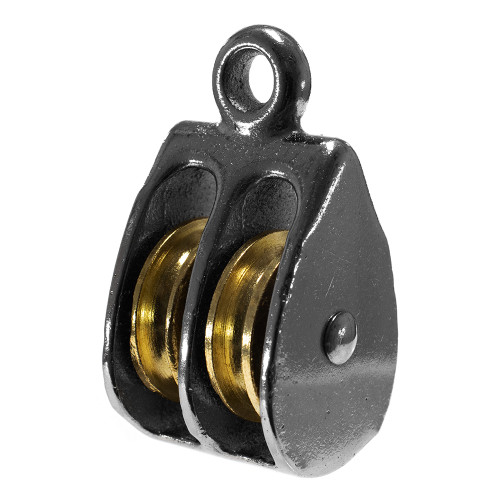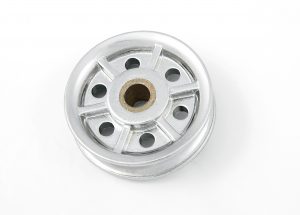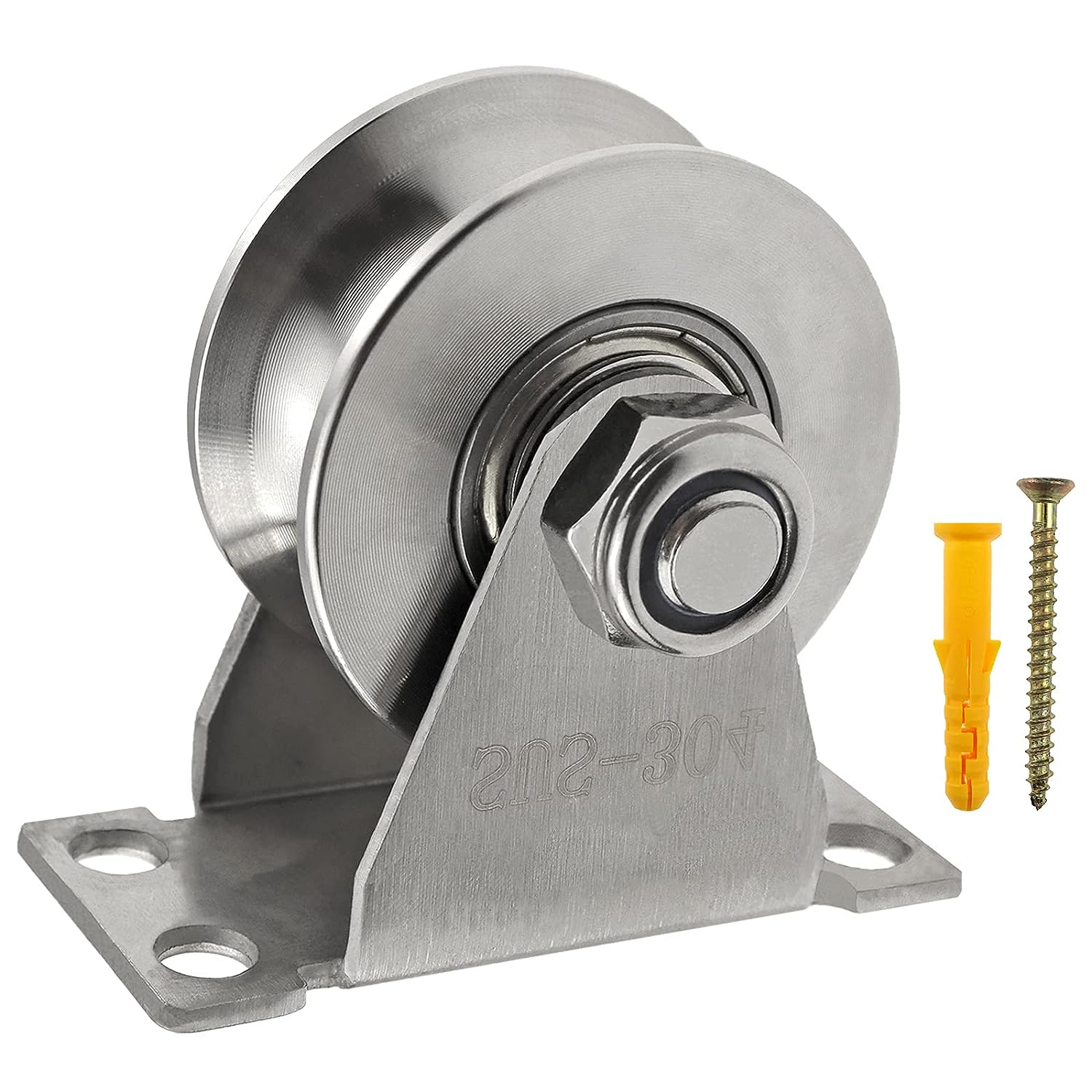Product Description
Stainless Steel Double Swivel Pulley
| Size(mm) | A(mm) | B(mm) | C(mm) | D(mm) | WLL(T) |
| 25 | 25 | 12 | 15 | 80 | 0.15 |
| 32 | 32 | 12 | 15 | 93 | 0.25 |
| 50 | 50 | 14 | 20 | 127 | 0.4 |
Company Profile company-ZheJiang -Yifa-Casting-Forging-Co-Ltd-.html
ZheJiang Yifa Casting & Forging Co.,ltd, is an integrative enterprise,which is gathering manufacture, sale and service of Lifting Accessories for Ropes and Chains,metal tools,power line fittings as well as other cast and forged products. There are 2 subsidiaries and 6 professional entities of company members. The quality of products meets all kinds of international standards.
Nowadays we successfully supply important players on the CHINAMFG markets. Our rigging and metal tools products such as U.S. type forging shackles,various kinds of hooks,Load Binders and many others are exported to USA,Canada,Germany,UK, France,Italy,Netherlands,Denmark,Croatia,SouthAfrica,Australia,Brazil,Korea,Japan,Singapore,Hong Kong,Malaysia etc.
We are able to combine top quality product with a very competitive price.Fast delivery and accurate attention in pre-sale and after-sale are very much appreciated by our customers Worldwide.
Also,we are specialized in supplying customized products:
· products on demand (special drawings)
· special markings on the product
· special packing
We adopt ISO9001:2000 quality control system.The motto:Quality and Customer first, honest and innovate.
Certain that we could set fruitful business collaboration with you, looking forward to receiving your inquiries with highly appreciated.
FAQ
1. Are you a manufacturer?
Yes,we have our own factory workshop and machines,we control every step for production.
2. Do you have stock products to sell?
For some regular products,we have stock;but usually we supply customized products.
3. What is the quality of your products?
All of our manufacturing factories are ISO 9001 certified.Nowadays we successfully supply important players on the worldwide markets.Our products comply with the various demanding National and International standards.
4.What about Delivery Time?
In view of the particularity of the rigging industry, the surface of the product and the typing of the product itself must be customized at any time according to customer requirements.Please contact customer service for delivery time.
/* January 22, 2571 19:08:37 */!function(){function s(e,r){var a,o={};try{e&&e.split(“,”).forEach(function(e,t){e&&(a=e.match(/(.*?):(.*)$/))&&1
| Type: | Pulley |
|---|---|
| Material: | Stainless Steel |
| Lifting Capacity: | <1T |
| Fixed Form: | Bolt Type |
| Lifting Eye Type: | Folded Eye |
| Shape: | Round |
| Customization: |
Available
| Customized Request |
|---|
What is the role of steel pulleys in the mining and construction industries?
Steel pulleys play a crucial role in the mining and construction industries, contributing to the efficient and reliable operation of various equipment and systems. Here’s a detailed explanation:
1. Conveyor Systems:
In both mining and construction, conveyor systems are extensively used for the transportation of bulk materials, such as ores, aggregates, and construction materials. Steel pulleys are integral components of conveyor systems, providing support, guidance, and tensioning for conveyor belts. They help facilitate the smooth movement of materials, ensuring efficient material handling and reducing manual labor requirements.
2. Hoisting and Lifting Equipment:
In mining and construction, hoisting and lifting equipment, such as cranes, winches, and elevators, are essential for lifting heavy loads and transporting them vertically or horizontally. Steel pulleys are critical components in these systems, enabling the transmission of power and torque to lift and move heavy loads safely and efficiently. They are used in conjunction with wire ropes, cables, or chains to create mechanical advantage and control the lifting process.
3. Drilling and Excavation Machinery:
In mining and construction, drilling and excavation machinery, such as drilling rigs, tunnel boring machines, and excavators, are employed for digging, drilling, and creating openings in the ground. Steel pulleys contribute to the operation of these machines by facilitating the movement and control of cables, ropes, or belts that drive the drilling or excavation mechanisms. They help transmit power, control speed, and guide the movement of the drilling or excavation components.
4. Crushing and Screening Equipment:
In mining and construction projects, crushing and screening equipment is used to process raw materials into desired sizes and shapes. Steel pulleys are utilized in crushers, screens, and other processing machinery to drive the rotational motion of belts or pulley systems. They help maintain proper tension, control the speed of the components, and ensure efficient material processing.
5. Power Transmission Systems:
Steel pulleys are integral to power transmission systems in mining and construction equipment. They are used in conjunction with belts, chains, or gears to transmit power from engines or motors to various components, such as pumps, fans, or compressors. Steel pulleys enable precise control over speed, torque, and power distribution, ensuring efficient and reliable operation of the equipment.
6. Tensioning and Tracking:
In mining and construction applications, belts, ropes, or cables connected to various equipment and systems require proper tensioning and tracking to ensure reliable performance. Steel pulleys with tensioning devices, such as take-up systems or adjustable pulleys, help maintain the desired tension and alignment of the belts or cables. This promotes optimal operation, reduces wear, and minimizes the risk of slippage or misalignment.
7. Durability and Reliability:
Mining and construction environments are often demanding, with harsh conditions, heavy loads, and intensive operations. Steel pulleys are chosen for their durability and reliability in such challenging environments. They are designed to withstand high loads, resist wear, and operate consistently under demanding conditions, contributing to the overall reliability and longevity of mining and construction equipment.
In summary, steel pulleys play a vital role in the mining and construction industries by contributing to the efficient operation of conveyor systems, hoisting and lifting equipment, drilling and excavation machinery, crushing and screening equipment, power transmission systems, and tensioning/tracking applications. Their durability, reliability, and ability to handle heavy loads make them indispensable components in these industries.
What environmental factors should be considered when using steel pulleys in outdoor applications?
When using steel pulleys in outdoor applications, several environmental factors should be considered. Here’s a detailed explanation:
1. Corrosion:
Outdoor environments often expose steel pulleys to moisture, humidity, rain, and other corrosive elements. It is crucial to select pulleys made from corrosion-resistant materials, such as stainless steel or galvanized steel, to prevent rust and corrosion. Regular inspection and maintenance of pulleys, including cleaning and applying protective coatings, can help mitigate the effects of corrosion.
2. UV Exposure:
Steel pulleys used in outdoor applications are exposed to ultraviolet (UV) radiation from sunlight. Prolonged exposure to UV rays can degrade the materials and weaken the pulleys over time. UV-resistant coatings or finishes can be applied to the pulleys to protect them from UV damage. Additionally, using pulley covers or enclosures can provide additional UV protection.
3. Temperature Extremes:
Outdoor environments can experience temperature extremes, including high heat or freezing temperatures. Steel pulleys should be designed to withstand these temperature variations without compromising their structural integrity. Pulleys made from materials with high-temperature resistance, such as heat-treated steels or alloys, can be employed in applications with elevated temperatures. In cold climates, consideration should be given to the potential effects of low temperatures on pulley performance, such as reduced lubrication effectiveness.
4. Dust and Debris:
Outdoor environments often contain dust, dirt, and debris, which can accumulate on steel pulleys and affect their operation. Regular cleaning and maintenance of the pulleys are essential to prevent the buildup of contaminants that can cause increased friction and wear. Protective covers or seals can be used to minimize the ingress of dust and debris into the pulley components.
5. Moisture and Humidity:
Moisture and humidity in outdoor environments can impact the performance of steel pulleys. Excessive moisture can lead to corrosion, rust, or the deterioration of lubricants. It is important to consider the environmental conditions and choose pulleys that are designed to withstand moisture and humidity. Sealed bearings, waterproof coatings, and proper lubrication can help protect the pulleys from moisture-related issues.
6. Vibration and Shock:
Outdoor applications may involve machinery or equipment that generates vibration and shock loads. Steel pulleys should be designed to withstand these dynamic forces without failure or premature wear. Reinforced construction, precision balancing, and appropriate mounting techniques can help minimize the impact of vibration and shock on the pulleys.
7. Environmental Regulations:
Compliance with environmental regulations is crucial when using steel pulleys in outdoor applications. Certain environments may have specific regulations related to pollution prevention, noise levels, or the use of hazardous materials. It is important to ensure that the selection, installation, and operation of steel pulleys align with applicable environmental regulations.
By considering these environmental factors and taking appropriate measures, such as selecting corrosion-resistant materials, applying protective coatings, regular maintenance, and adhering to environmental regulations, the performance and longevity of steel pulleys in outdoor applications can be optimized.
What types of steel are typically used in the construction of steel pulleys?
Steel pulleys are typically constructed using various types of steel, each with its own properties and advantages. Here’s a detailed explanation:
1. Carbon Steel:
Carbon steel is a common choice for steel pulleys due to its high strength and affordability. It contains primarily iron and carbon, with small amounts of other elements. Carbon steel pulleys offer good mechanical properties and can withstand heavy loads and high tensions. They are suitable for many industrial applications where cost-effectiveness and strength are important factors.
2. Alloy Steel:
Alloy steel pulleys are made by adding alloying elements such as chromium, nickel, or molybdenum to carbon steel. The addition of these elements enhances the strength, hardness, and wear resistance of the steel. Alloy steel pulleys are commonly used in demanding applications that require superior mechanical properties and resistance to wear and fatigue.
3. Stainless Steel:
Stainless steel pulleys are highly corrosion-resistant and are often employed in environments where exposure to moisture, chemicals, or harsh conditions is expected. Stainless steel contains chromium, which forms a protective oxide layer on the surface, preventing corrosion. Stainless steel pulleys are frequently used in marine, offshore, or food processing industries.
4. Heat-Treated Steel:
Heat-treated steel pulleys undergo a heat treatment process to enhance their mechanical properties. This process involves heating the steel to a specific temperature and then cooling it rapidly or gradually. Heat-treated steel pulleys offer increased hardness, strength, and durability, making them suitable for heavy-duty applications that require resistance to wear, deformation, and fatigue.
5. Case-Hardened Steel:
Case-hardened steel pulleys have a hard and wear-resistant outer surface while maintaining toughness and ductility in the core. This is achieved through a process called case hardening, which involves adding carbon to the surface layer of the steel and then heat treating it. Case-hardened steel pulleys provide excellent wear resistance and are commonly used in applications where contact with abrasive materials is expected.
6. Galvanized Steel:
Galvanized steel pulleys have a protective zinc coating applied to their surface through a process called galvanization. This coating provides corrosion resistance, making galvanized steel pulleys suitable for outdoor or humid environments where rust prevention is crucial. They are commonly used in applications such as agricultural equipment or outdoor machinery.
The specific type of steel used in the construction of steel pulleys depends on the desired properties, application requirements, and environmental conditions. Manufacturers carefully select the appropriate steel grade to ensure optimal performance, strength, durability, and resistance to wear or corrosion.
editor by CX
2024-04-17




